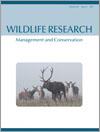Context. When understanding species occupancy, estimation of detection probability for the target species is often required, provided by repeated surveys. However, if the actual detection probability of the species is determined experimentally, such estimates are not required, and the reliability of the occupancy data obtained by a particular survey effort can be determined.
Aims. The aim of this study was to determine the detection rate of tadpoles using visual field surveys, as well as to explore the effects of survey time, species and tadpole density on the tadpole-detection rate. The suitability of visual surveys for detecting tadpole occupancy was also assessed.
Methods. Batch-identified tadpoles were released into several pools and repeatedly counted over successive days to calculate detection rates using visual observation. In Experiment 1, the effects of tag colour, survey time (morning vs night) and species on the detection rates of two species of tadpoles (Babina subaspera and Odorrana splendida) were examined. In Experiment 2, the effects of tadpole density on O. splendida were examined.
Key results . Detection rates varied by survey time, species and tadpole density; mean rates ranged from 0.2 to 0.6 for B. subaspera and 0.4 to 0.8 for O. splendida, with higher rates at night. There was a negative relationship between detection rate and tadpole density. Based on these detection rates, it was calculated that single visual surveys of O. splendida tadpoles can achieve detection probabilities near 1.0 when more than four individuals occur in a patch.
Conclusions . Variations in detection probability should be considered in field surveys. If the factors that cause variations in detection rates are controlled, visual surveys of tadpoles should, at least in some species, provide detection probabilities near 1.0.
Implications. When repeated surveys to estimate species occupancy are not practicable, determination of the actual detection probability of the target species using real detection rates provides a robust alternative approach.





